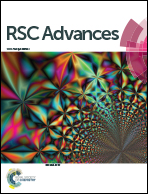Preparation of magnetic porous NiFe2O4/SiO2 composite xerogels for potential application in adsorption of Ce(iv) ions from aqueous solution
Abstract
In this work, a novel magnetic porous adsorbent was prepared via a sol–gel method for the removal of Ce(IV) from aqueous solution. The NiFe2O4/SiO2 composite xerogels were characterized using SEM, BET, FT-IR, XPS, TEM, VSM and XRD. In addition, the effects of initial concentration, amounts of adsorbents, contact time, solution pH and temperature on the adsorption of Ce(IV) were investigated via batch adsorption studies. The results verify the formation of hierarchically porous structures with a specific surface area of 1085.3 m2 g−1. The adsorption capacity for Ce(IV) at 25 °C is 114.56 mg g−1 (91.65%), the adsorption of Ce(IV) onto the composite xerogels was better described by the pseudo-second-order kinetic model, and the data fit well with the Langmuir isotherm model. Thermodynamic parameters such as standard enthalpy (ΔH0), standard entropy (ΔS0) and standard free energy (ΔG0) indicated that the adsorption of Ce(IV) onto composite xerogels was spontaneous and endothermic within the temperature range of 278–338 K. Moreover, the adsorbents showed good performance and recycling ability and could be separated by applying a magnetic field.



 Please wait while we load your content...
Please wait while we load your content...